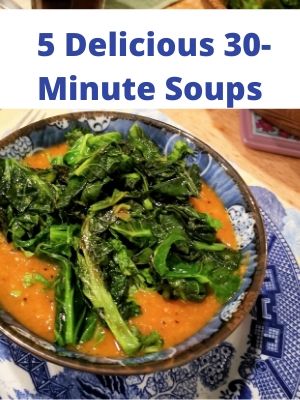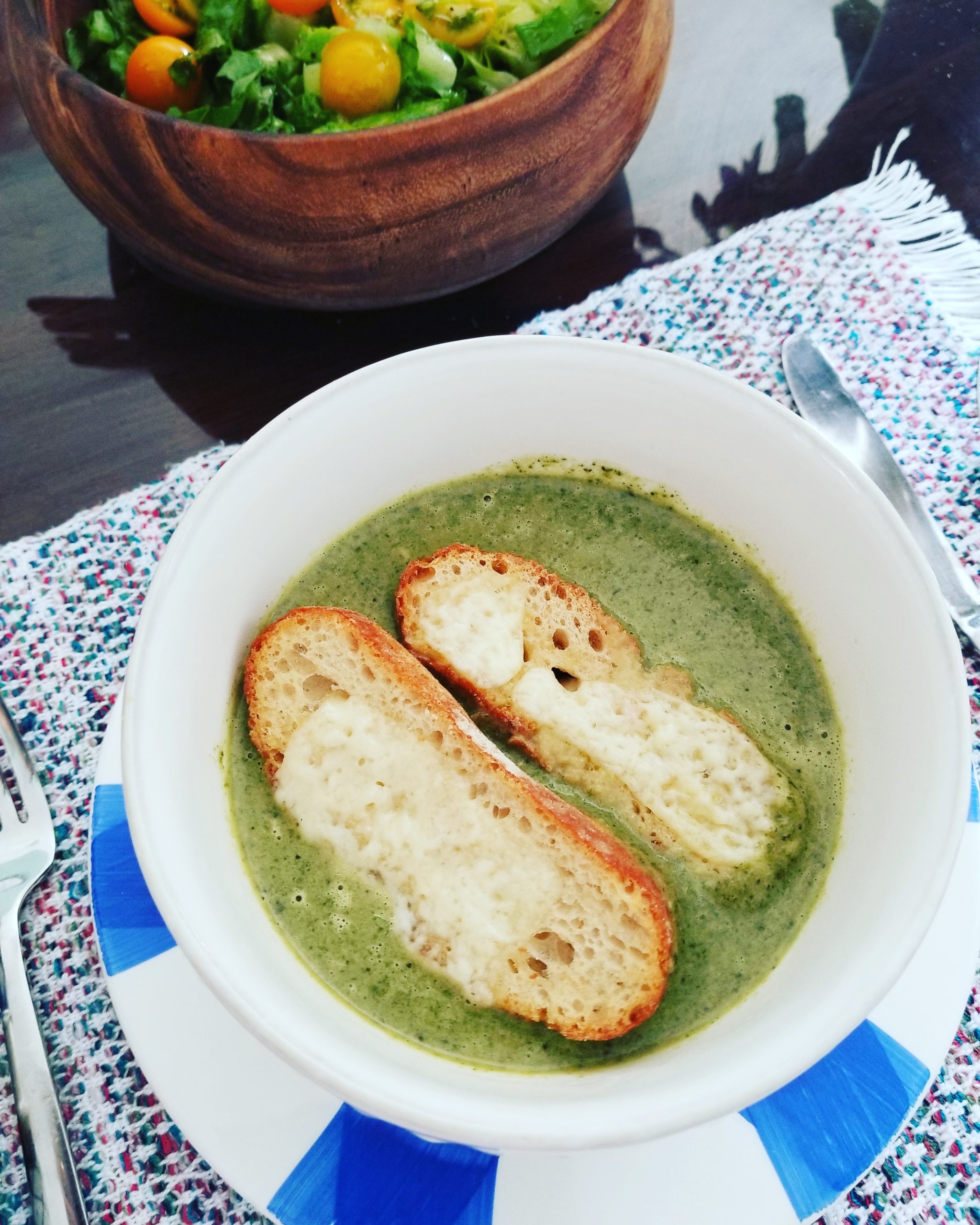



Why I Love Making Soups
Soups are the ultimate 30-minute dinner from scratch! Plus, soups are almost always colorful food, which means they’re packed full of vitamins. I make a soup two or three times a week and our family doesn’t get tired of them. Here I’ll outline the basics for starting your own soups from scratch and give you my recipes for Cream-of-Any-Green-Vegetable and Rustic Tomato Soup as well as links for recipes for 3 of my favorite go-to-soups with notes about altering to fit your personal taste, or what you have in your pantry.
Meat-Free on Purpose
You’ll notice that all five of these soups are meat-free. I’m not vegetarian but we try to eat less and less meat in our household for health and environmental reasons. A lot of people aren’t aware that meat production, especially conventional big-industry meat production, is really destructive to our environment. A 2009 study by the Natural Resource Defense Council found that four-fifths of the deforestation across the Amazon rain-forest could be linked to cattle ranching. And the water pollution from factory farms—where pigs and other livestock are contained in tight quarters—can produce as much sewage waste as a small city. And, the use of antibiotics in these mega industry farms has led to the development of antibiotic-resistant strains of bacteria that threaten human health and the environment. A life-cycle analysis conducted by Environmental Working Group on the production and distribution of 20 common agricultural products found that red meat such as beef and lamb produces 10 to 40 times as many greenhouse gas emissions as common vegetables and grains. The good news is that we all can do our part to lower greenhouse gas emissions by eating less meat, and a fun easy way to start is with delicious vegetarian soups!
The basics to a delicious soup include:
- Creating a flavorful base, usually by sauteing onion and garlic (add celery, carrots, beets, potatoes etc. depending on the recipe) with butter or olive oil. Please use real butter or a quality non-hydrogenated oil; cooking with margarine or lard is going to ruin your base flavor IMHO;
- Filtered water or organic stock;
- Your “headline flavors” which usually determine what you’re naming your soup (Tomato, Mushroom&Barley, Hearty Vegetable for example);
- Your luxury touches – not always needed but usually appreciated – Wine, organic heavy cream or coconut milk and fresh herbs, for example
My Go-To Cream-of-Any-Green Vegetable-I-have-in-my-Fridge Soup
I’ll be making this tonight! I love it because it’s a little different every time I make it and it’s ready in about 30 minutes (Serves 3-4);
- Sauté 1 chopped organic sweet onion in 1T organic butter and 1T organic olive oil for 3-5 minutes, until soft and aromatic;
- Add chopped fresh organic garlic (I would use 2-3 cloves) and stir for a minute;
- Add 1/2 cup of dry organic white wine and let simmer for a couple of minutes so that the alcohol evaporates;
- Add 2-3 cups of organic dark green vegetables. Tonight I’ll be using organic broccoli (one head) and organic baby kale (one 5 oz container or 1 bunch if you’re able to buy it without the container). Collard greens, chard, radish greens or spinach are all delicious too!
- Season with sea-salt and pepper and let greens cook together for a couple of minutes, stir it a couple of times so that the greens are nicely coated with the onion/garlic/butter/wine base;
- Add 3 cups of organic vegetable broth, bring to a boil, then lower heat and simmer for 10 minutes;
- Turn off heat and puree with an Immersion blender until completely smooth (depending on your greens about 3 minutes);
- Add 1/2 cup of organic heavy cream, re-heat until it just starts to simmer (don’t boil) and it’s ready to serve!
- I like to garnish this with an organic cheese-toast-crouton that I make during the 10 minutes the soup is cooking:
- This recipe serves 3-4 people so place enough bread for each person to have at least one, maybe two pieces (I use sourdough usually but multi-grain works too, a dense bakery bread is going to work better than a conventional sandwich loaf ) on a parchment-paper lined baking sheet and spray or baste lightly on one side with olive oil. Place the oiled sides downside onto the baking sheet. Place a thin slice of organic cheese (I use cheddar, Swiss or whatever I have in the fridge) on each piece of bread. Toast in a preheated oven at 390 degrees for about 8 minutes, until the cheese is bubbling and starting to brown at the edges.
- Place a cheese-toast on top of each bowl of soup and serve with a fresh green salad. Bon Appétit!
Note: If you can’t find an organic bread you like look for the non-GMO label, this will at least guarantee you’re not eating GMO wheat, which is resistant to pesticides and therefor usually sprayed more heavily than non-GMO wheat And if you can’t find organic butter or cheese opt for those labeled no- rBST, which is an artificial growth hormone. Canada and the European Union do not use rBST so dairy products, including butter, made in these countries will be rBST-free even if it’s not labeled.
Three More of my Favorite Soup Recipes:
I had to smile as I went through recent soup-making photos because you’ll see quickly that I love NYTCooking! I”m on their mailing list so I receive their recipe ideas weekly – the most talented chefs and cooks contribute to their enormous collection of recipes and it’s so much fun to look at their beautiful photos and pick out new gorgeous meals to try. You can subscribe to their mailing list or follow them on Instagram or Facebook for a fresh batch of inspiration whenever you need it.
- Creamy Cauliflower Soup is Soooo Easy and it’s vegan too! It’s delicious and the rosemary olive-oil makes the soup and croutons feel decadent. Using an Immersion Blender will save you about 10 minutes since you don’t have to transfer back and forth from a blender and then re-heat, making this a 30-minute meal! https://cooking.nytimes.com/recipes/1020764-creamy-cauliflower-soup-with-rosemary-olive-oil
- Red Lentil Lemon Soup is delicious and I made it even more colorful by topping it with organic chard cooked in 1T of olive oil and a pinch sea salt: Clean and trim stems from greens, heat pan over a medium-high heat and let oil get to the point where it’s not smoking but you can see that it’s super hot – add the salt, then a full bunch greens to the pan and stir-fry for about 30 seconds, until you see the leaves of the greens start to get crispy. Serve immediately as a garnish on top of the soup. Red Lentils cook quickly so I take issue that this recipe has them cooking for 30 minutes – I cook them for 12-15 minutes over a medium heat, stirring regularly, and they are the perfect consistency. https://cooking.nytimes.com/recipes/1016062-red-lentil-soup-with-lemon?smid=pin-share
- Caramelized Onion and Beet Soup is a bit exotic, so beautiful and quick to prepare! https://www.goboroot.com/caramelized-onion-and-beet-soup/
So, How does Making Organic Soup from Scratch Save the World??
Good question! Cooking with organic produce supports organic farming, and organic farms use production practices with environmental benefits such as water management practices, no-till or minimum tillage, habitat maintenance for beneficial insects and vertebrates and biological pest control. These ecologically protective practices contribute to enhanced ecosystem services and benefit water quality, soil health and biodiversity (Find out more at https://ofrf.org/research/organic-faqs/ ).
According to Pew Research there were more than 14,000 certified organic farms in the United States in 2016, as per latest available data from the U.S. Department of Agriculture’s National Agricultural Statistics Service. This represents a 56% increase from 2011, the earliest comparable year. As the number of organic farms has increased, so too have sales of certified organic products: U.S. farms and ranches sold nearly $7.6 billion in certified organic goods in 2016, more than double the $3.5 billion in sales in 2011. This progress still only represents a tiny sliver (about 1% ) of agricultural land in the US and switching to organic isn’t easy for farms (there’s a three-year transition period to cleanse the soil from conventional farming, so you’ll now see food labeled “certified transitional” in grocery stores) but farmers do have more incentive than ever to switch to organic farming – this means healthier less toxic soil and less contaminants running off into our streams and rivers, ponds and drinking water!
Eating more vegetarian meals and buying grass-fed organic meat when you do eat meat will send a strong message (with your pocketbook!) to the meat industry that factory farms are no longer viable, as well as being bad for our health and bad for our environment.
Finally, cooking from scratch at home generally requires a lower environmental footprint than eating processed foods or carryout. You’re using less packaging- less plastic wrapping, less cardboard boxes, no carry-out containers or bags. Whole plant food requires less energy to produce than highly manufactured processed food. Less production energy means a lower environmental footprint. I call that saving our world in a major way!
I hope you enjoy these recipes, please write in if you have your own from-scratch soup recipes that you’d like to share!




